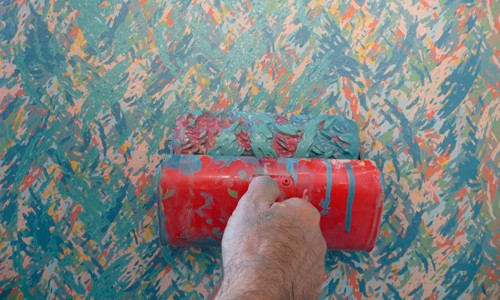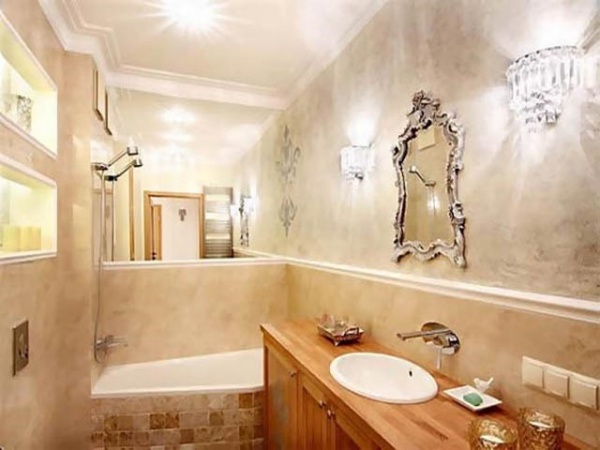Types of textured paint for walls, application technology + photo, video
Exquisitely and tastefully finished walls are a very important element of decor for any room. Almost all existing finishing materials have some drawbacks that limit their use, especially in indoor areas, which require not only beauty, but also safety and environmental friendliness. Therefore, the optimal material for interior and exterior wall decoration is textured paint. Only it allows you to create incredibly chic, bewitching surfaces on the walls, allowing any manifestations of your own, even the richest and irrepressible imagination.
The process of working with textured paint is incredibly simple and easy, so it can be used by people with a complete lack of experience in construction and finishing works. A distinctive feature of the ongoing painting work can be considered the ability to create your own textures, as well as sufficient time to correct what you did not like or did not work out. To hone your “skill”, you can practice on a piece of plywood or a small section of the wall (in this case, before the main painting, the “training” composition of the textured paint must be completely removed with a steel spatula, and the wall must be dried and primed).
Textured wall paint has undeniable advantages over other materials, and among the main ones are the following:
- frost resistance;
- resistance to constant exposure to UV rays;
- the plasticity of the resulting coating, which does not allow the wall to become covered with small cracks (with natural shrinkage of buildings);
- insensitivity to dampness, preventing the formation and reproduction of the fungus;
- the finished surface does not absorb odors at all;
- dust and dirt-repellent properties, facilitating subsequent care;
- high environmental friendliness, making it possible to use in children's rooms;
- the ability to use on any grounds - from brickwork to wood;
- huge scope for creativity when it is self-applied.
In addition, it is worth noting its hypoallergenicity and the minimum requirements for the quality of the surface used for applying textured interior paints.
Applying textured paint
Textured wall paint is applied, according to reviews, extremely easily, and the use of any complex special tool is not required. Do-it-yourself textured wall paint can be somewhat modified, which will allow you to create your own, unusual textures. So, to obtain a rough relief surface, pure sawdust can be added to the paint, and quartz sand is added to obtain a structure with sharp edges. The paint is applied in a fairly thick layer, so it perfectly covers all the cracks, chips and small irregularities on the wall.
The choice of application tool is devoid of any standards, and depending on what effect you want to achieve, you can use:
- natural sponge;
- textured (structural) roller of various lengths and diameters;
- comb;
- putty knife.
In general, applying textured paint is possible even with your hands, since it is absolutely safe, and the decor created “by hand” can become quite unexpected, interesting and unique.
A little about applying textured paint with a roller is shown in the video
Variants of possible reliefs
Textured painting of walls with water-based paint allows you to get several basic textures.

Stages of work
Applying textured paint with a roller, of course, is neither particularly difficult nor time-consuming surface preparation - and this is its huge advantage. However, the minimum amount of work to be done is still required:
- it is advisable to tap the wall with a hammer, which will reveal areas where the old plaster is about to fall out (this must be eliminated);
- large cracks need to be repaired;
- the entire surface intended for painting the walls in the apartment with textured paint should be primed with an acrylic primer, preferably marked "deep penetration".
Advice ! Best results are achieved when the applied compound and base are at room temperature.
Before working with such paint, it requires very thorough mixing, and it is better if a drill with a mixer nozzle is used for this. Re-mixing is necessary after adding the selected filler and color. There are several mandatory rules, otherwise the effect may differ from what was intended:
- the application of textured paint should be carried out in a thick enough layer to be able to create the intended texture;
- it is desirable to work immediately on the entire surface where the texture will be created, since during breaks in work places of “joints” may be noticeable, which will visually worsen the impression of the whole work;
- the tool that is planned to be used must be prepared in advance;
- after drying, textured compositions for walls with effects can be additionally painted with acrylic compositions.

Choosing the best textured paint
Painting the walls with textured paint allows you to get a unique, sophisticated interior. With this, now no one argues. But in some cases, people complain that instead of unprecedented beauty, it turned out completely different from what they expected. In almost every such fact, the buyers themselves are to blame, who did not have a clear idea of \u200b\u200bwhat they ultimately wanted to receive. If almost everyone understands how to work with textured paint, few know about the intricacies of its choice.
Each coloring composition to give the wall texture and relief has its own graininess. The more pronounced and deep the texture is required, the greater the graininess should be chosen, and since each manufacturer labels this parameter in its own way, do not neglect the seller's advice when buying. Another important parameter of textured coatings is the base.
- Mineral. The most budget option, consisting of cement and lime, and produced in the form of a dry powder. Most often, with the help of the mineral composition, they give texture to the outer walls of buildings.
- Silicone . The most common option that can be used both inside and outside buildings. Creates a vapor-permeable coating that is resistant to moisture, temperature extremes and aggressive environments.
- Silicate. The most expensive, but very practical option. such a coating is not afraid of any exposure to the atmosphere, the treated surface does not absorb dirt and dust, and is easy to clean. Use is allowed only in combination with a primer on a similar basis.
- Acrylic. The most convenient, ready-to-use composition that allows tinting and the introduction of the required fillers.

Enthusiastically engaged in the creation of a new, creative interior of your own home, you should not forget that in any business you need, if not experience, then at least skill, so training is necessary before work. In addition, you first need to be very clear about what kind of surface you want to get. To do this, you can not only look at online photo galleries, but also try to draw your future interior.
You can apply textured paint to a separate area, and using various tools or improvised means, see what kind of texture is obtained. It is important to understand that a pattern that looks good in a small area may not be appropriate on the entire wall. In addition, do not forget that all tools used to work with textured paint must be clean. Naturally, elementary safety requirements cannot be neglected - personal protective equipment and sufficient ventilation of the room will not interfere.




